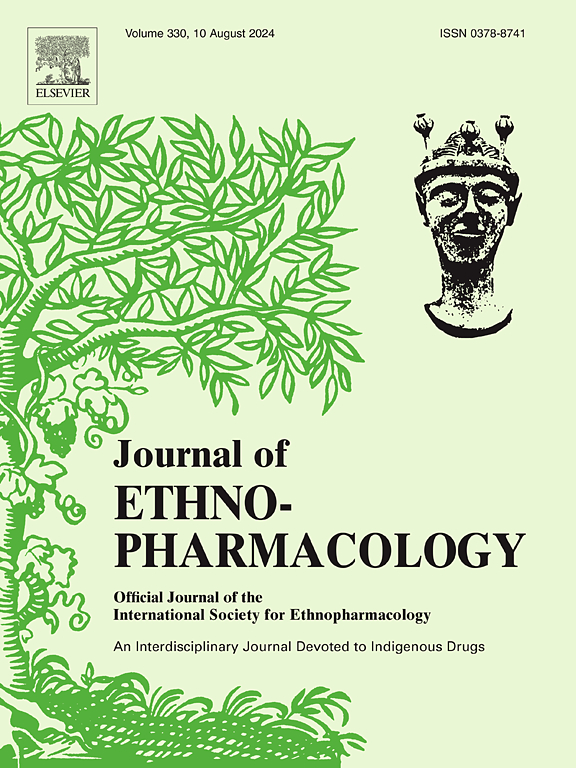糖酵解代谢重编程及TLR4/NF-κB/NLRP3通路调控:蒲地蓝消炎两种剂型抗炎活性比较分析
IF 4.8
2区 医学
Q1 CHEMISTRY, MEDICINAL
引用次数: 0
摘要
民族药理学相关性:普地兰消炎口服液(PDL-L)是一种解热解毒的药物,在中国用于治疗喉咙痛和扁桃体炎等炎症,是一种标准化的中成药。普地兰配方颗粒(PDL-G)是该药物的另一种剂型,其成分与PDL-L相同。然而,PDL-L和PDL-G抗炎作用的差异尚未得到评价,其潜在机制有待进一步探讨。研究目的:本工作系统地研究了PDL-L和PDL-G的比较药效学差异及其潜在机制。材料与方法:采用高效液相色谱法对PDL-G中主要生物活性成分进行定性分析,确保药品质量标准。采用小鼠耳廓肿胀模型、腹腔毛细血管通透性模型和大鼠足跖水肿模型,比较PDL-L和PDL-G的抗炎作用。此外,为了建立炎症表型,在受精后3天的斑马鱼胚胎中,将2-nL LPS溶液(3mg /mL)微注射到卵黄囊区域进行炎症攻击。通过幼虫存活分析、观察中性粒细胞和巨噬细胞迁移情况,比较PDL-L和PDL-G抗炎疗效。采用实时荧光定量PCR (Quantitative real-time PCR, qRT-PCR)检测lps刺激斑马鱼中促炎细胞因子和TLR4/NF-κB/NLRP3通路组分的转录水平。采用酶联免疫吸附试验(ELISA)和qRT-PCR评价PDL-L和PDL-G对LPS和Poly (I:C)诱导的小鼠急性肺损伤(ALI)的抑制作用。苏木精-伊红(H&E)染色评价病理损伤。同时评估ALI小鼠糖酵解相关蛋白的表达和TLR4/NF-κB/NLRP3信号的激活。结果:通过同步色谱检测,实现了PDL-G和PDL-L中8种主要成分的定性分析。PDL-L和PDL-G在多种炎症模型中均表现出显著的抗炎作用。两种剂型均能减轻耳部肿胀、腹腔毛细血管通透性和足部水肿,但疗效无显著差异。在斑马鱼炎症模型中,PDL-L和PDL-G均通过抑制TLR4/NF-κB通路联合抑制NLRP3炎性体,显著抑制lps刺激斑马鱼幼鱼中性粒细胞浸润和巨噬细胞积累,减少lps刺激炎症因子的释放,延长幼鱼存活。在LPS/Poly (I:C)诱导的小鼠ALI模型中,PDL-L和PDL-G均通过抑制支气管肺泡灌洗液和肺组织中促炎介质的分泌而有效减轻肺部炎症。此外,这些处理下调糖酵解相关蛋白的表达,抑制TLR4/NF-κB/NLRP3炎症级联的信号活性。结论:本研究首次提供了PDL-G在抗炎作用上与PDL-L相当甚至优于PDL-L的实验证据。我们的研究结果还表明,PDL-G通过调节糖酵解和TLR4/NF-κB/NLRP3通路发挥抗炎活性。这些发现证实了PDL-G在临床上替代PDL-L的潜力,为其在炎症性疾病中的治疗翻译提供了分子基础。本文章由计算机程序翻译,如有差异,请以英文原文为准。

Modulation of glycolytic metabolic reprogramming and the TLR4/NF-κB/NLRP3 Pathway: comparative analysis of anti-inflammatory activity between two dosage forms of Pudilan xiaoyan
Ethnopharmacological relevance
Pudilan xiaoyan oral liquid (PDL-L), a antipyretic and toxin-eliminating agent used in China for inflammatory conditions including sore throat and tonsillitis, is a standardized Chinese patent medicine. Pudilan formula granules (PDL-G), which share the same composition as PDL-L, are another dosage form of this medication. However, the difference in anti-inflammatory efficacy between PDL-L and PDL-G remains unevaluated, and their potential mechanisms require further exploration.
Aim of the study
The present work systematically investigates comparative pharmacodynamic differences between PDL-L and PDL-G and their underlying mechanisms.
Materials and methods
Qualitative analysis of key bioactive constituents in PDL-G was conducted using high performance liquid chromatography (HPLC) to ensure pharmaceutical quality standards. The anti-inflammatory effects of PDL-L and PDL-G were compared using three established models: the mouse auricular swelling model, the abdominal capillary permeability model, and the rat paw edema model. Additionally, to establish an inflammatory phenotype, zebrafish embryos at 3-day-post-fertilization received microinjection of 2-nL LPS solution (3 mg/mL) into the yolk sac region for inflammatory challenge. Comparative evaluation of anti-inflammatory efficacy between PDL-L and PDL-G were compared by larval survival analysis and observation of neutrophils and macrophages migration. Quantitative real-time PCR (qRT-PCR) was employed to measure transcriptional levels of pro-inflammatory cytokines and TLR4/NF-κB/NLRP3 pathway components in LPS-challenged zebrafish. The inhibitory effects of PDL-L and PDL-G on LPS- and Poly (I:C)-induced acute lung injury (ALI) were evaluated in mice through enzyme-linked immunosorbent assay (ELISA) and qRT-PCR. Pathological damage was evaluated via hematoxylin-eosin (H&E) staining. A concurrent evaluation was performed on glycolytic-related protein expression and TLR4/NF-κB/NLRP3 signaling activation in ALI mice.
Results
Qualitative profiling of eight principal constituents in PDL-G and PDL-L was achieved through simultaneous chromatographic detection. Both PDL-L and PDL-G exhibited remarkable anti-inflammatory effects in several types of inflammation models. Both two formulations reduced ear swelling, abdominal capillary permeability, and paw edema with no significant difference in efficacy. In zebrafish inflammation model, PDL-L and PDL-G both significantly suppressed neutrophils infiltration and macrophages accumulation in LPS-challenged zebrafish larvae, reduced the release of LPS-stimulated inflammatory factors, and prolonged larval survival through the TLR4/NF-κB pathway inhibition coupled with NLRP3 inflammasome suppression. In murine models of LPS/Poly (I:C)-induced ALI, both PDL-L and PDL-G effectively mitigated pulmonary inflammation through suppression of pro-inflammatory mediator secretion in bronchoalveolar lavage fluid and lung tissues. Furthermore, these treatments downregulated the expression of glycolysis-associated proteins and suppressed the signaling activity of the TLR4/NF-κB/NLRP3 inflammatory cascade.
Conclusion
This investigation first provides experimental evidence that PDL-G demonstrates comparable or even superior efficacy to PDL-L in anti-inflammatory effects. Our results also show that PDL-G exerts anti-inflammatory activity through regulation of glycolysis and the TLR4/NF-κB/NLRP3 pathway. These findings substantiate PDL-G's clinical substitution potential for PDL-L, providing a molecular rationale for its therapeutic translation in inflammatory disorders.
求助全文
通过发布文献求助,成功后即可免费获取论文全文。
去求助
来源期刊

Journal of ethnopharmacology
医学-全科医学与补充医学
CiteScore
10.30
自引率
5.60%
发文量
967
审稿时长
77 days
期刊介绍:
The Journal of Ethnopharmacology is dedicated to the exchange of information and understandings about people''s use of plants, fungi, animals, microorganisms and minerals and their biological and pharmacological effects based on the principles established through international conventions. Early people confronted with illness and disease, discovered a wealth of useful therapeutic agents in the plant and animal kingdoms. The empirical knowledge of these medicinal substances and their toxic potential was passed on by oral tradition and sometimes recorded in herbals and other texts on materia medica. Many valuable drugs of today (e.g., atropine, ephedrine, tubocurarine, digoxin, reserpine) came into use through the study of indigenous remedies. Chemists continue to use plant-derived drugs (e.g., morphine, taxol, physostigmine, quinidine, emetine) as prototypes in their attempts to develop more effective and less toxic medicinals.
 求助内容:
求助内容: 应助结果提醒方式:
应助结果提醒方式:


